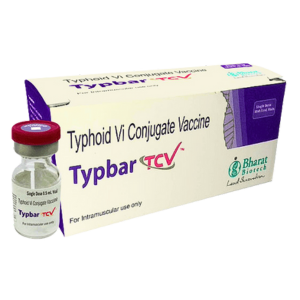Typhoid Vi Conjugate vaccine
Typbar TCV® is a vaccine containing polysaccharide of Salmonella typhi Ty2 conjugated to Tetanus Toxoid. Vi Capsular polysaccharide of Salmonella typhi alone elicit B cell responses, but the conjugation of bacterial polysaccharide to a protein carrier provides foreign peptide antigens that are presented to the immune system eliciting antigen-specific CD4+ Th cells, referred to as T-dependent…
Description
Typbar TCV® is a vaccine containing polysaccharide of Salmonella typhi Ty2 conjugated to Tetanus Toxoid. Vi Capsular polysaccharide of Salmonella typhi alone elicit B cell responses, but the conjugation of bacterial polysaccharide to a protein carrier provides foreign peptide antigens that are presented to the immune system eliciting antigen-specific CD4+ Th cells, referred to as T-dependent antibody responses. A hallmark of T-dependent responses, which are also elicited by toxoid is to induce both higher-affinity antibodies and long-term immune memory.
Typbar TCV® is the world’s first clinically proven conjugate Typhoid vaccine. Further, Typbar TCV® is the only approved vaccine for children and infants less than 2 years of age. During the phase 3clinical study, a single dose of Typbar TCV® elicited 4-fold sero-conversion rates of 98.05%, 99.17% and 92.13% in subjects between ≥6 months to 2 years, ˃2 to 15 years and ˃15 to 45 years respectively.Results of this study were published in the Journal of Clinical Infectious Diseases.
Results from a human challenge study carried out at University of Oxford have demonstrated that the vaccine is safe, 100% immunogenic, and prevents up to 87.1% of infections, when using real life definitions of typhoid fever. Typbar TCV® has been recommended by the experts at the WHO-Strategic Advisory Group for routine immunizations and is WHO prequalified.
Bharat Biotech’s typhoid conjugate vaccine shows nearly 82% efficacy at 12 months in a Phase-3 trail carried out in Nepal. It can be be given to babies as young as six months. Currently available typhoid vaccines have 60-70% efficacy and cannot be given to children younger than two years.
A typhoid vaccine (Typbar TCV) developed by the Hyderabad-based Bharat Biotech has shown 81.6% efficacy in preventing typhoid fever at 12 months in a Phase-III clinical trial. The trial was carried out in Nepal in over 10,000 children who received the vaccine.
A single does of the vaccine was found to be effective in preventing typhoid in children aged nine months to 16 years. The vaccine confers protection two-three weeks after vaccination. The duration of protection is currently not known. The results of the trial were published in The New England Journal of Medicine (NEJM).
The Typbar TCV vaccine was recommended by WHO’s Strategic Advisory Group of Experts on Immunization (WHO-SAGE) in December 2017. The WHO prequalified the vaccine in January 2018.
Typhoid fever is caused by highly contagious Salmonella Typhi bacteria. Nearly 11 million fall sick due to typhoid and about 1,17,000 deaths are reported each year. The bacteria spread through contaminated food and water.
The Typbar TCV typhoid vaccine tested in Nepal is a conjugate vaccine. A conjugate vaccine is one in which the antigen (which is a polysaccharide in this case) is chemically linked to a carrier protein.
Issues with other vaccines
Two other typhoid vaccines — polysaccharide typhoid vaccine and live, weakened typhoid vaccine — are already used commercially. But the efficacy of these vaccines to protect against typhoid is lower than the conjugate vaccine that has now been tested in Nepal.
“The other two vaccines offer 60-70% protection unlike the conjugate vaccine which confers nearly 82% protection. Two doses of live, weakened typhoid vaccine are needed to reach 60-70% protection,” says Dr. V. Krishna Mohan, Executive Director at Bharat Biotech. “More importantly, the conjugate vaccine can be given to babies as young as six months, while the other two vaccines cannot be given to children below two years of age.” According to SAGE, in high-incidence settings, a large proportion of severe typhoid fever cases occur in children aged below two years.
While typhoid bacteria can be treated with antibiotics, the microbes have developed resistance against multiple antibiotics. Multi-drug resistant typhoid bacteria are seen in south Asia including India. Since 2016, extensively drug-resistant (XDR) typhoid outbreaks have been reported from Sindh province in Pakistan. According to an Editorial accompanying the paper, XDR typhoid has been found in India, Bangladesh, and Pakistan.



 Book a Test
Book a Test
 Download Reports
Download Reports
 Health Packages
Health Packages
 Home Med Service
Home Med Service

